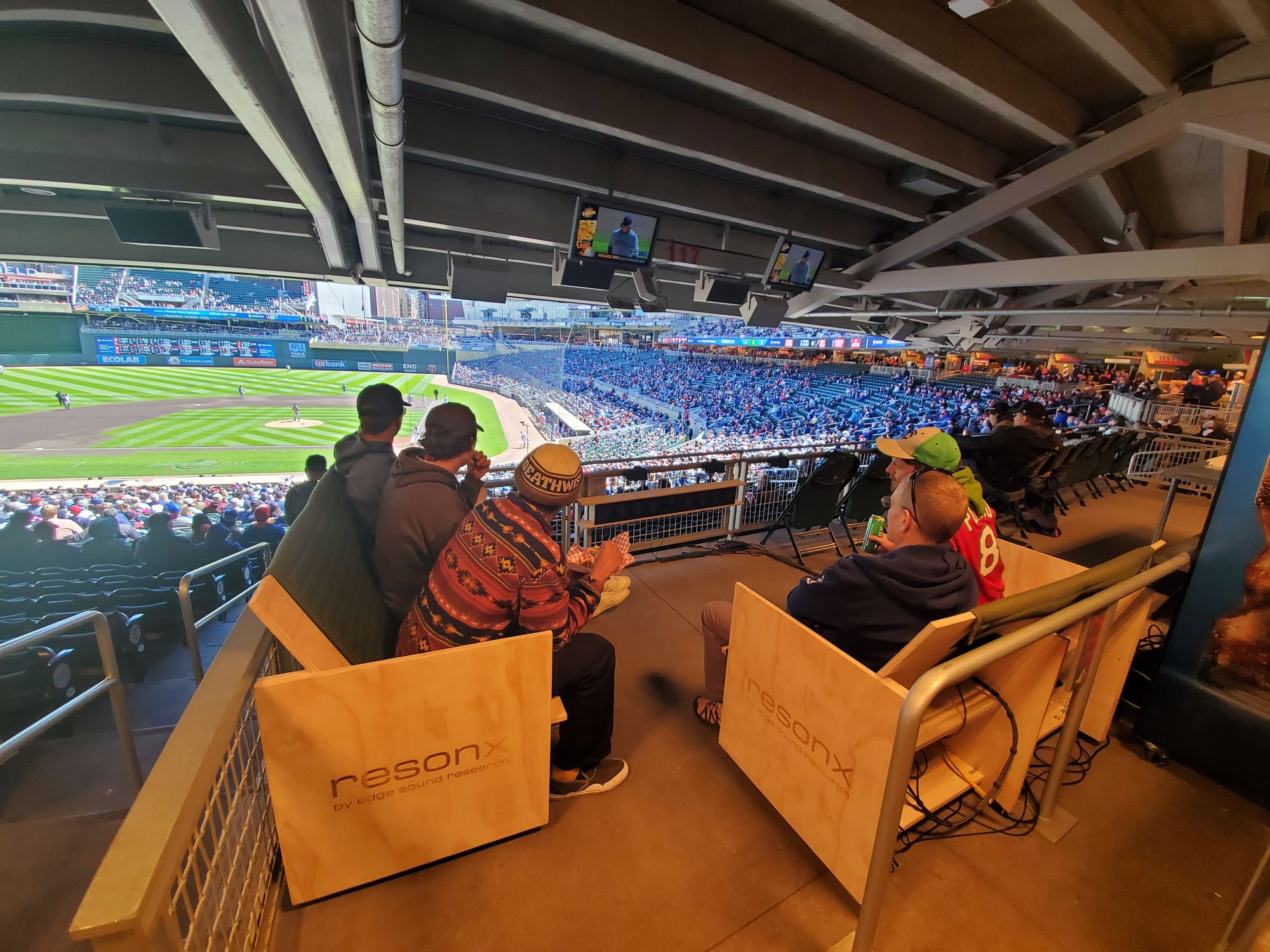Sports Stadiums Are Turning to Immersive Sound to Keep Fans Engaged
Samson Amore is a reporter for dot.LA. He holds a degree in journalism from Emerson College. Send tips or pitches to samsonamore@dot.la and find him on Twitter @Samsonamore.

In 2022, the Minnesota Twins experimented with a new technology that brought fans the ability to physically feel the sounds they were hearing in the stadium in the back of their seats as part of a new immersive way to experience baseball.
The tech was made by Riverside-based startup Edge Sound Research, which built a mobile lounge – basically, a small seating section equipped with its technology and on wheels to travel around the stadium – for Twins fans to experience what it calls “embodied audio” around Target field. It was a bid on the Twins’ part to keep fans more engaged during the game, and Edge Sound Research CEO Valtteri Salomaki said the Twins were impressed.
“Feedback overall was great. That actually gave us the confidence to move away from us trying to do too much of a consumer product and double down on the venue side,” he said of Edge’s business plans.
Even after the coronavirus pandemic restrictions were lifted, sports team owners and stadium operators are struggling to gain new fans.
The NHL’s slumping ratings show a grim picture: Ratings for the league were down 22% in February, and attendance was down 6% on average last season. Some NBA teams hiked ticket prices to compensate for lackluster attendance last season, but overall attendance this season appeared to rebound, with only four teams posting negative fan growth. Most NBA stadiums were at least at 80% capacity or higher this season, though it remains to be seen if this growth will sustain.
NFL attendance took a big hit during the pandemic, but the size of the average NFL crowd grew by 3.5% last year. Die-hard fans will likely always want to turn out for their particular team. But in order to keep pace and grow, all sports leagues are embracing tech or other entertainment to differentiate themselves and entice first-time fans to become repeat ticket buyers. “Sports organizations to survive today have to not think of themselves as competing in sports, but competing in entertainment,” said Salomaki.
To compensate for the dipping attendance, some teams and stadium operators are turning to technology that can augment the traditional live sports experience. Some teams, including the LA Clippers, have even turned to virtual reality as a way to keep fans interested.
To that end, Edge Sound Research is one of seven international companies selected by the NBA as part of its research and development accelerator. Its technology is synced to the audio feeds of the broadcasters, commentators and stadium music and vibrates people’s seats when there’s audio stimuli. The goal is to make spectators “feel” every sound they’re hearing, and even the frequencies they might miss during a game.
Salomaki told dot.LA his cofounder Ethan Castro’s experience with hearing loss at a young age led him to experience sound through vibrations, which eventually was the inspiration for the company. Edge Sound Research sells both hardware and software. The hardware component is a pack of transducers, which vibrate back and forth, varying in intensity or cadence depending on what Edge’s software dictates.
Anyone who’s been to a concert and felt the bass in their chest or played a video game with a vibrating controller is familiar with the feeling of sounds producing haptic feedback. But according to Salomaki, Edge is going beyond augmenting typical sounds. For example, in a crowded stadium, it could boost engagement – it’s hard to ignore the baseball if you’re feeling the crack of a bat in your seat every time it’s hit.
“We send signals to each of those devices that vibrates it based off the material it’s attached to, to ensure that you hear and feel the entire frequency of sound consistently, no matter what you’re attaching the device to,” Salomaki explained. He called the technology “embodied audio.”
Salomaki added that when he first tried the technology it was a “holy s— moment.” Adding that,, “the way we as humans have always thought about audio is [that] audio is what you can hear. That was the wrong question to ask… audio engages not only what you hear, it’s also what you feel.”
The way audio is delivered hasn’t changed much since the dynamic speaker was invented in 1925, Salomaki noted. “Audio has been stuck to its invention a century ago, with speaker coils,” he said. That unfamiliarity with a truly immersive sound experience could be overwhelming – ask any kid who’s been literally blown away by a 4-D Imax movie. But Salomaki said ResonX, Edge’s software that controls the panels’ vibrations is made to ensure the tactile audio has a range of intensity. “My co-founder’s PhD shows you can actually feel up to 5,000 Hertz, and we want to give you that full range,” he said.
That said, it’s not just traditional sports that could take advantage of haptic seating. Salomaki said Edge’s goal is to dominate the stadium market, but also lean into applications at esports venues, especially given the tie-in with the pro “NBA 2K” esports league that kicked off a new season earlier this month.
In addition, Salomaki said that being a local company (both he and Castro are alumni of University of California, Riverside) makes him eager to add Edge Sound Research’s technology into LA County’s rich live entertainment ecosystem. “I care about the different clubs, venues and immersive museums and everything that lives in LA today,” he continued. “That’s where I would love to be able to start, because LA is a great playground.”
- How LAFC Is Using AI To Prevent Players From Getting Injured ›
- How LA-Based Super Hi-Fi Hopes to Change Streaming Audio Using AI ›
- Former TikTok Lead Creates an Audio-Driven Dating App ›
- Graphene Stands to Revolutionize Audio, but First It Has to Get Past Industry Inertia ›
Samson Amore is a reporter for dot.LA. He holds a degree in journalism from Emerson College. Send tips or pitches to samsonamore@dot.la and find him on Twitter @Samsonamore.



 Image Source: Perelel
Image Source: Perelel
 Image Source: Valar Atomics
Image Source: Valar Atomics Image Source: Waymo
Image Source: Waymo Image Source: Apple
Image Source: Apple